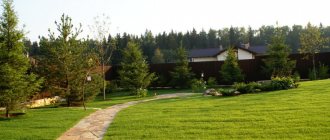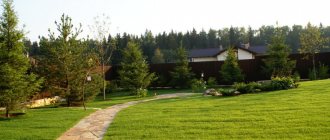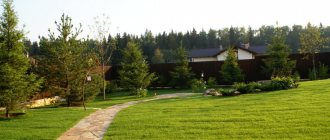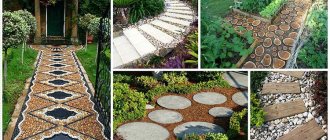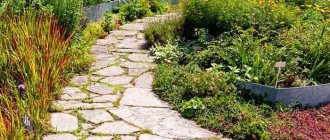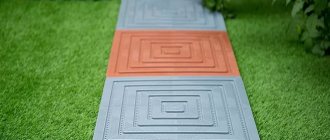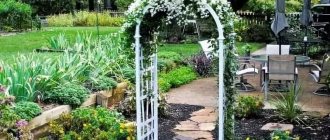Garden paths on a dacha, personal plot or in the courtyard of a private household are not only an important element of landscape design, necessary for comfortable movement between objects of the territory, but also a way of zoning and decoration. The correct arrangement of garden paths will allow you to spend as little time and effort as possible moving between elements of landscape design, and a beautiful, practical and durable design will allow you to decorate your yard or summer cottage, create a creative design that will be the envy of your neighbors and the pride of guests of your urban or country house with an adjoining house territory. Even in a small private courtyard, paths are necessary for safe and comfortable movement between the main and secondary objects of the territory - a country or city house building, a garage, a gazebo, outbuildings, a children's corner or playground, a swing, a barbecue area, a swimming pool or a pond.
Gravel path
This is a budget option for designing a country path. Thanks to its structure, gravel will perfectly allow water to pass through empty areas, which will allow you to walk comfortably in rain and mud.
This material will help you easily give the desired shape for the garden path, which can always be changed or supplemented. This is a simple, effective and mobile option for landscaping.
One of the disadvantages is that gravel perfectly allows weeds and grass to pass through. And it will have to be cleaned periodically. Like any number of small elements, gravel is difficult to keep in one position. And to maintain the integrity of the design, it is better to use borders for garden paths.
Using lawn to create a path
What are the nuances when making garden paths from lawn? To maintain an attractive appearance, the lawn requires constant care. Watering, weeding and cutting.
It is also important to have constant natural light. With constant use, it quickly gets trampled, bald spots appear and the overall appearance deteriorates.
One of the advantages is that with proper care, the path looks very beautiful and creates a feeling of comfort and well-groomed. In addition, it is pleasant to walk on it.
There is an interesting life hack for caring for such a path. To make lawn maintenance easier, choose a width that matches the width of your lawn mower. This will save time significantly.
What materials can be used for construction
The fundamental factors when choosing a building material are the general architectural appearance of the site , financial capabilities and the availability of construction skills.
Almost anyone can lay a path with gravel, but only an experienced craftsman can lay brick or mosaic.
Let's look at the main types of materials and their features.
Natural stone
In landscape design, expensive types of granite, marble, porphyry, and basalt are used. You can choose from available sandstone, limestone, tuff, shale, and dolomite. Stones differ in color, processing, and ability to absorb moisture.
If there is financial opportunity, sawn stone slabs are used, which create exclusive designs, but are expensive.
Winding path made of sawn natural stone
Some types of limestone and tuff actively absorb moisture. To preserve the strength of the stone, it is recommended to coat its surface with moisture-repellent agents.
The advantages of the material include durability and environmental friendliness. Disadvantages include high cost and significant weight. In humid climates, the surface of the stone becomes covered with an ice crust in winter, making it easy to slip on it.
Wood
Various types of wood are suitable for laying garden paths:
1Log cuts
Log cuts. One of the cheapest options
2Wooden tiles
Wooden Tiles for Outdoor Use
3Boards
Using boards for arranging paths and borders
The material is not durable and resistant to moisture, so it requires regular treatment with moisture and bioprotective compounds. The advantage is environmental friendliness and availability of wood.
To create paths, you can use scraps left over from the construction of the main facilities.
The most durable species: oak, larch.
To make the wood last longer, it is treated with hot drying oil and laid on a sand bed with a layer of polyethylene film. An elevation is made in the central part of the trench so that moisture can roll off.
You can arrange the cuts in any order, filling the gaps with sand, small crushed stone, and gravel. If the gaps are filled with soil, grass will soon grow on it.
Paving slabs and paving stones
The materials are characterized by high levels of strength, durability, resistance to changes in humidity and temperature. Their service life is at least 10 years. However, the paving stones themselves and their installation are quite expensive. This is especially true for owners of large dachas.
Fan layout of paving stones. A decorative border is laid along the edges, level with the paving stones.
When constructing a path from tiles, it is necessary to constantly monitor the surface according to the building level, otherwise it will be uncomfortable to walk on it. It is better not to use elements with cracks; they will quickly become unusable.
Gray paving slabs combined with lawn grass look attractive
Brick
The material is an alternative to paving stones. For landscape design, only clinker bricks are used. The cost of materials and installation work is high. Elements and borders are fixed with cement mortar.
Red brick herringbone masonry
Laying can be done with the wide or narrow part of the brick at the top, combining elements of different colors and textures. Properly executed brickwork on the ground will last a long time.
Combined masonry of brick, natural stone slabs, paving slabs
Concrete, including decorative varieties
The material is highly durable and durable. It is not afraid of moisture, combines perfectly with stone or tiles, and also serves as a basis for their installation.
Special plasticizer additives are added to the composition of decorative concrete, which increase resistance to mechanical damage, sunlight, and temperature changes.
Paths near the house made of printed concrete
Using special technologies and plasticizer additives, it is possible to obtain an imitation of natural stone from concrete.
The optimal solution is prepared:
- from 1 part cement
- 2 parts sand
- 3 shares of crushed stone
Installation of formwork along the edges is required . The solution can be poured directly onto the prepared area or slabs can be made from it in molds.
Decorative slabs cast from concrete, laid out crosswise
Gravel and crushed stone
Even a novice master can create bulk objects from gravel or crushed stone . The pebbles just need to be compacted thoroughly. The shape of the filling can be either straight or curved.
The cost of the material is low with a long service life and good strength.
Combined road of stone slabs, organic material and gravel with cement curb
The disadvantages of bulk objects made of pebbles include:
- Difficulty in cleaning up dirt and fallen leaves
- low permitted load
- difficulty moving on poorly compacted surfaces
Designer mosaic masonry made of gravel, natural stone and cement mortar
To maintain the clarity of the forms of the filling, it is necessary to install a border along the edges. To get rid of weed germination, lay a layer of film or treat the stones with herbicides.
Plastic elements
Plastic products for decorating garden paths are made in the form of slabs and paving slabs. The material is lightweight, moisture resistant, and comes in a variety of shapes and sizes.
The price of plastic plates is affordable for everyone.
Tiles made of green plastic will harmoniously fit into the surrounding landscape
It will take a little time to build the deck on the ground; the elements include fastening systems. But as we know, plastic tends to fade in the sun and cannot withstand significant loads.
Another option for black plastic slabs
Also used for arranging paths are bark, lawn grass in rolls, ceramic tiles and their chips, and tennessite, consisting of a mixture of lime, clay and ceramic chips.
Next, we’ll look at ways to make tracks yourself from the most popular materials.
Tile path
Paving slabs add a sense of elegance to the space. The main feature is the minimum requirements for care and maintenance. With high-quality installation, tiles will serve you for many decades. And keep a well-groomed appearance.
But there are also disadvantages to this style. First of all is the price. This type of design is considered the most expensive. Even DIY installation will not help reduce costs.
Some tips for laying paving slabs yourself:
- To add more rigor to the design, use a garden border.
- The tiles must be laid when it has not rained and will not rain for at least a week. This is the most important condition. It is its compliance that determines the service life of the track.
- If you live in an area with heavy and prolonged rain, you should consider drainage for the path.
Preparatory stage
Any construction on a site must begin with a layout. It can be done on paper or using special programs.
Site plan created by a computer program
Planning is carried out in several stages:
1First, the area is marked. Paths should be located so that it is convenient to reach all buildings and structures. On a sheet or monitor, draw the boundaries of the site, the location of residential buildings, outbuildings, greenhouses, bathhouses, outdoor toilets
2All objects are connected by straight or winding lines, which indicate future objects. It is important to correctly calculate their parameters: two people walking towards each other should not interfere with each other. Therefore, the width of the garden path is chosen 100-150 cm, paths 45-65 cm
3In swampy areas and regions where there is a lot of rainfall, it is necessary to provide a drainage system. Drains are built on both sides of the paths to help drain excess water. If this is not done, frozen water will spoil the material of the paths: concrete, wood, paving slabs
4Calculate the required slope, which will allow water to drain and not stagnate on the surface of the paths. It is especially important to make an elevation when building near flower beds and beds so that the coating does not suffer during watering
5Planned objects are tried on the ground. Pegs are driven in along the paths of future paths and threads are pulled. This way you can evaluate how convenient it will be to use them.
Layout of the site on paper, where buildings, paths, large trees are indicated
Straight paths are easier to lay out and maintain, while curved paths look more attractive.
Landscape designers recommend creating winding paths in small areas; they help visually expand the boundaries of the garden. They need to be located away from large trees, as the roots can damage the created surfaces.
After marking, they begin to remove the top fertile soil layer in the marked areas. The depth of the trench will depend on the height of the sand cushion. If the soil in the area is loose, then crushed stone or gravel is poured into the bottom of the trench, and then sand.
When laying bricks or using tiles, lay a border on the sides of the path. The width of the trenches in this case increases by two thicknesses of the curb stone.
river stone
The simplest river stone can turn a path into a work of art. By selecting a sufficient number of light, gray and dark stones of similar shade, you can lay out any picture or ornament. This is long and painstaking work. But the resulting design will be absolutely unique. And you can be proud of yourself, listen to rave reviews from friends and family.
First of all, it is necessary to sort the stones by color, and also get rid of defective stones and stones with obvious flaws. To facilitate further work, you can sort the stones by size.
It is important to create a feasible sketch of the future path. You can use ready-made ideas from the Internet or come up with your own design. It's easiest to style curls or squares.
Path using tree bark
Bark is a cheap material that can be purchased at any hardware store. An interesting feature of the bark is that it prevents weeds from growing. Accordingly, such a path will require a minimum of care and time.
Flaws:
- it is necessary to add bark to the path every season;
- Some of the material is carried by the wind or on the soles of shoes, which also affects the need to add bark to some areas.
Do-it-yourself paths at the dacha - 50 photos
Photo by Aniston Grace on Unsplash
The article was updated and changed on January 3, 2022.
Add to bookmarks
